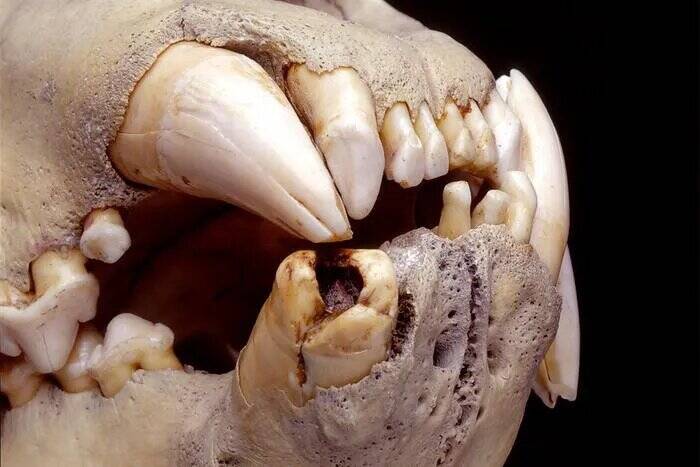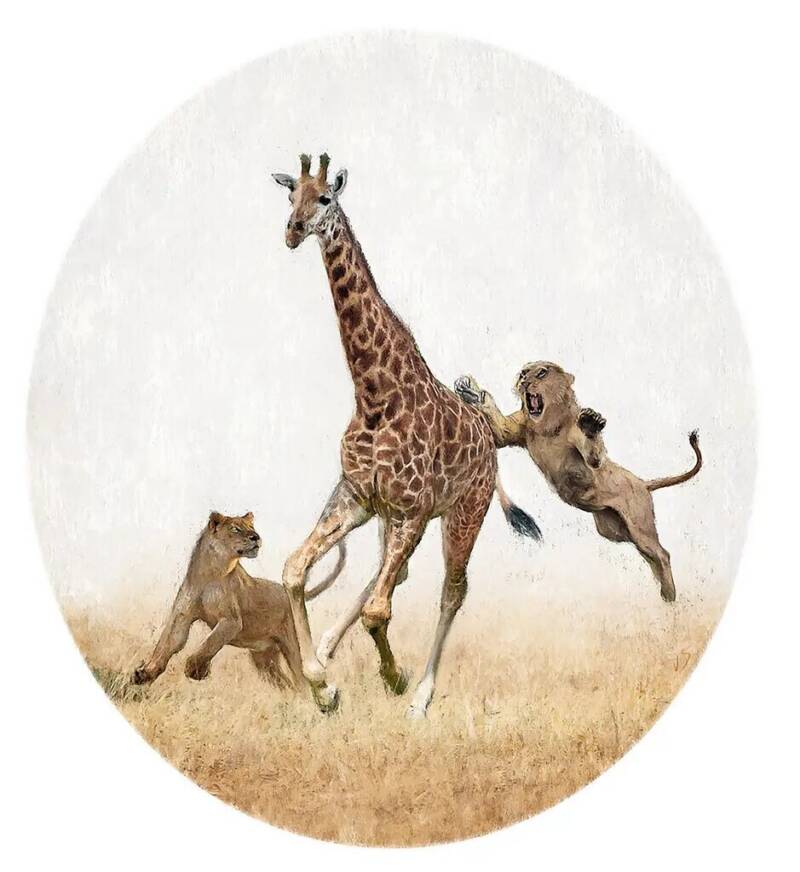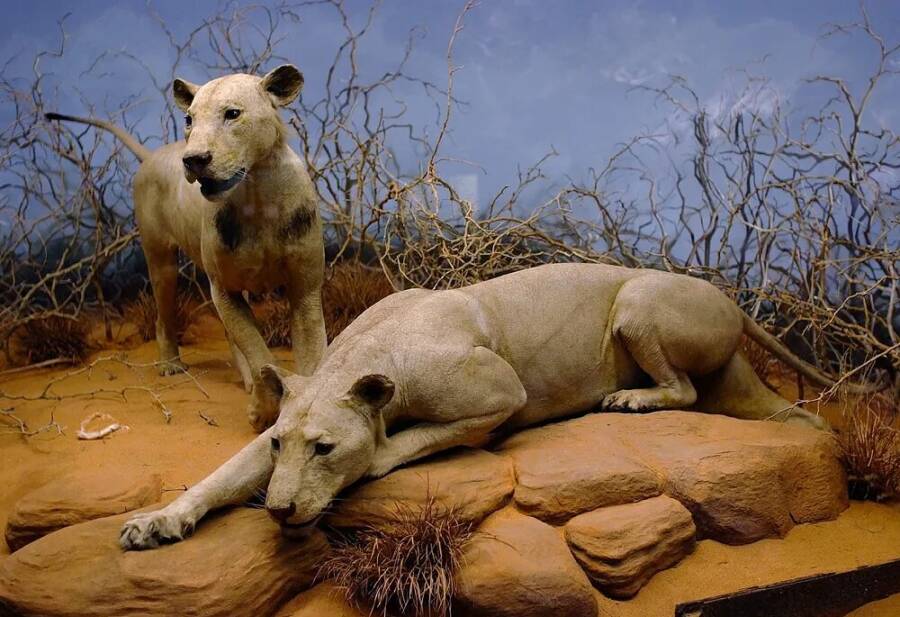Back in 1898, deep in the heart of Kenya, a gruesome tale unfolded. Two lions, now infamous as the Man-Eaters of Tsavo, went on a killing spree. Their reign of terror lasted from March to December of that year, and their victims were railway workers constructing a bridge over the Tsavo River. Estimates suggest the lions killed as many as 135 people during those terrifying months.
But these weren’t just any lions. They had a taste for humans—something exceedingly rare in the animal kingdom. Now, thanks to a recent DNA analysis of hair samples discovered inside their jaws, we have a clearer picture of what these predators actually feasted on. Spoiler alert: it wasn’t just humans.
The Man-Eaters of Tsavo
Let’s rewind to March 1898. The British Empire was expanding its railway network through Africa, and a group of Indian laborers was tasked with building a bridge over the Tsavo River. It should have been just another job, but as dusk fell, danger lurked.
Two male lions, without manes, began to stalk the camps. At first, the attacks were sporadic, but soon they became an almost nightly event. The lions would drag men from their tents, never to be seen alive again. Imagine the terror, waking to screams in the middle of the night, knowing that you or your friends might be next.
Workers tried everything—fires, fences, even thorny bushes—to deter the beasts. Nothing worked. The situation became so dire that the British Prime Minister at the time, Lord Salisbury, addressed it in the House of Lords. According to a report by the Chicago Tribune, he said, “The whole of the works were put to a stop because a pair of man-eating lions appeared in the locality and conceived a most unfortunate taste for our workmen.” Unfortunate? That’s an understatement, Lord Salisbury.
Things got so bad that workers fled, leaving the railway project at a standstill. That’s when Colonel John Henry Patterson, a British Army officer, stepped in.
Also Read: The Full Story of the 1986 FBI Miami Shootout: The Day that Changed Law Enforcement Forever
The Hunt for the Killers

Colonel Patterson wasn’t just overseeing the bridge’s construction anymore—he had a new mission: kill the lions. Setting traps and ambushing the beasts took longer than anyone expected. These lions were clever, almost uncannily so. But on December 9, 1898, the first lion was finally shot. Twenty days later, the second met the same fate.
With the lions dead, the railway project resumed, and the bridge was completed by February 1899. But even in death, the Man-Eaters of Tsavo remained an enigma. Why did they target humans? It’s a question that has puzzled researchers for over a century.
New DNA Analysis Sheds Light on Their Diet
Fast forward to 2024, and we’re finally getting some answers, thanks to science. A study recently published in Current Biology has provided a new level of insight into the diets of these lions, and let me tell you, it’s fascinating.
Researchers at the Field Museum in Chicago—where the lions’ remains are preserved—used DNA extracted from hair samples found in the lions’ teeth to get a complete picture of their eating habits. In 2009, isotope testing had already revealed that one lion consumed at least 10.5 humans and the other about 24.2. But it turns out, humans weren’t their only meal.
The lions also feasted on giraffes, oryxes, waterbucks, wildebeests, and zebras. But here’s where it gets even more interesting: the closest wildebeest herds were around 50 miles from the lions’ territory. So, either these lions were traveling far beyond their assumed range, or historical data about wildebeest territories needs some serious updating.
The Lions Were Brothers
Another twist to the tale? The lions were brothers. DNA analysis revealed that they shared each other’s hair in their teeth, suggesting they groomed one another, a behavior often seen between bonded lions. It’s a detail that adds an almost heartbreaking layer to the story—these were not just lone killers but family members working together to survive.
Why Did They Eat Humans?
The big question remains: why did these lions develop a taste for human flesh? Researchers believe the answer lies in their teeth. Dental issues, likely caused by injuries or infections, may have made it difficult for the lions to hunt larger, tougher prey like wildebeests or zebras. Humans, being softer and slower, became easy targets.
David Western, head of the Kenya Wildlife Service, summed it up best: “Lions don’t normally have much to do with humans at all, if they can help it.”
What’s Next? Human DNA and Family Connections
But the discoveries don’t stop there. Researchers also found human DNA in the hair samples. This opens up a whole new avenue for study: identifying the descendants of the victims. As anthropological geneticist Ripan S. Malhi explained, “There are potentially descendants, or a descendant community that may or may not want this type of analysis done, or maybe they do—we just don’t know yet.”
It’s a sensitive issue, to be sure. Imagine discovering that your great-great-grandfather was killed by a lion over a century ago. Some families might want to know, others might prefer the past to remain in the past.
The Legacy of the Man-Eaters

Today, the Man-Eaters of Tsavo are more than just a historical footnote. They serve as a reminder of the power of nature—and the consequences when humans encroach too far into the wild. They also continue to fascinate us, as their remains, now housed at the Field Museum, draw visitors from around the world.
So, what can we learn from the Tsavo lions? Perhaps it’s a lesson in survival, not just for the humans who fled their camps in terror, but for the lions themselves. Desperate times called for desperate measures, and in the end, the Tsavo lions did what they had to do to stay alive.
But their legacy doesn’t end there. As we continue to unlock the secrets hidden in their bones and teeth, we gain a deeper understanding of both the past and the fragile relationship between humans and the wild.
What Do You Think?
What’s your take on this story? Would you want to know if your ancestors were victims of the Tsavo lions, or would you prefer to let the past lie? Drop your thoughts in the comments below, and don’t forget to share this with fellow history buffs! You never know what might lurk in the shadows of history, just waiting to be uncovered.

